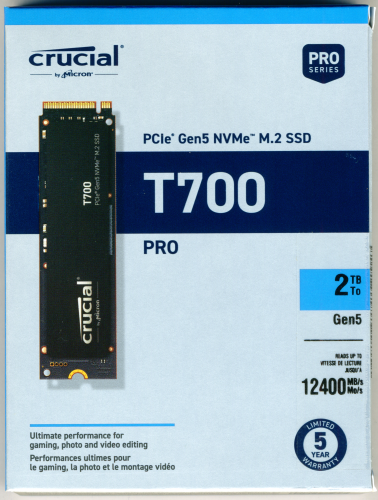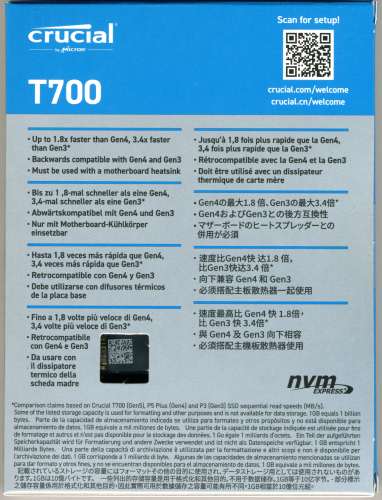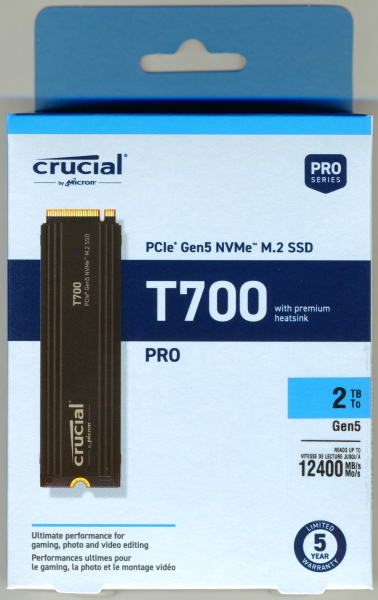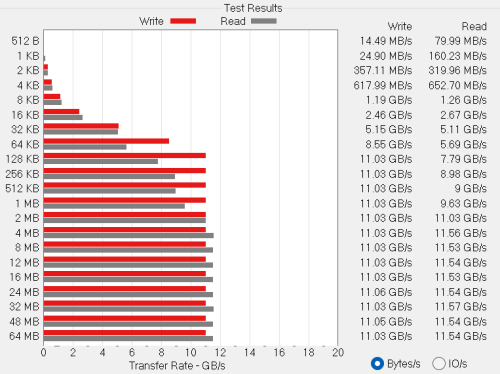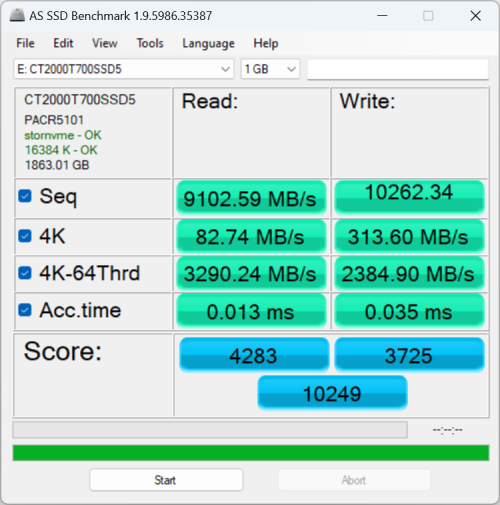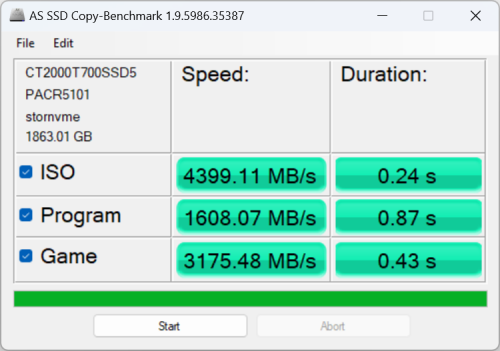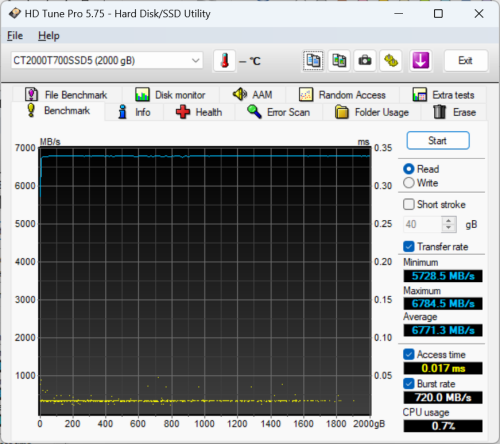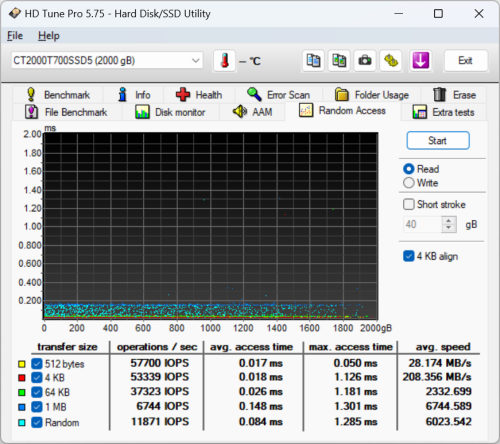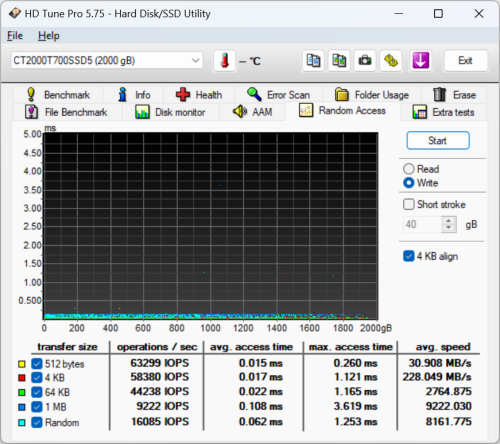

Model: Crucial T700 2TB PCIe Gen5 NVMe Solid State Drive
Manufacturer: Crucial
Provided By: Crucial
Crucial is a global brand of Micron Technology, Inc., one of the largest memory and flash storage manufacturers in the world. The company's product lineup includes award-winning solid state drives (SSDs) and computer memory upgrades (DRAM) for more than 50,000 systems. These products have been qualified and approved by major original equipment manufacturers and every single module has been rigorously tested at the component and module level. Each SSD also undergoes over a thousand hours of prerelease validation testing and hundreds of qualification tests to ensure optimal reliability and performance.
Earlier this year, Crucial unveiled its first Gen5 NVMe SSD, the T700. Designed for enthusiasts, gamers, creators, and professionals who need next generation storage, this M.2 form factor drive is powered by Phison's new PS5026-E26 controller and is available with up to 4TB of Micron's industry-leading 232-layer 3D TLC NAND flash. The T700 is also available with or without a custom-designed premium heatsink and is equipped with an ultra-fast PCIe Gen 5.0 x4 NVMe 2.0 interface to deliver up to 12,400 MB/s read and 11,800 MB/s write speeds. To top it all off, the drive is optimized for Microsoft’s DirectStorage API software technology, which allows games to load much faster by leveraging the full speed of NVMe SSDs.
The T700 is available in 1TB, 2TB and 4TB capacities. For this review, Crucial sent us the 2TB version of the drive, which is capable of delivering up to 12,400 MB/s sequential read and 11,800 MB/s sequential write speeds as well as up to 1,500K random read and write IOPS.
| Crucial T700 2TB PCIe Gen5 NVMe Solid State Drive | |||||||||||||||||||||||||||
General Specifications
Performance
Reliability
Environmental
Other Features
|
Needless to say, this is only a taste of what the T700 has to offer. To give you an idea of what to expect, we'll take a closer look at Crucial's new PCIe Gen5 SSD and then see how well it performs. Does the T700 have what it takes? Can it deliver the performance and features that we've come to expect from Crucial? Keep reading as we find out.
Both versions of the T700 come in small, blue and white boxes. Along with a picture of the drive, the packaging advertises a number of its key features including its 2TB capacity, support for PCIe 4.0 NVMe technology, maximum read speed and 5 year warranty.
Inside the box, you'll find the T700 as well as a small guide with information on where you can get additional help and download the migration and cloning software.
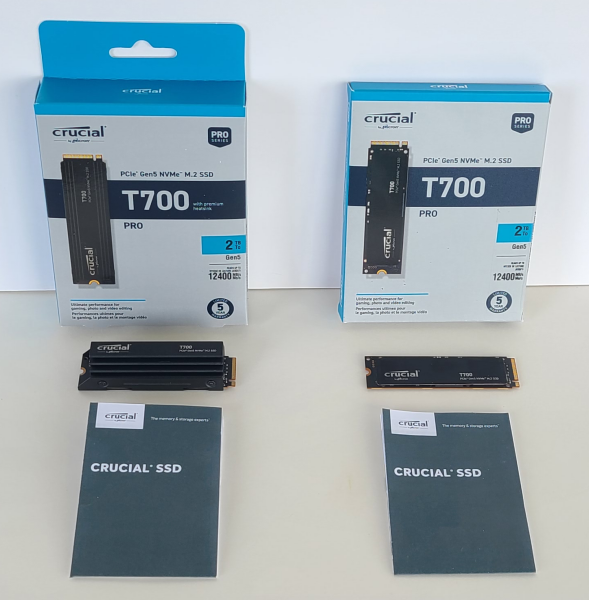
Physical Features:
The T700 uses the 2280 form factor for M.2 (NGFF) SSDs. The heatsink-less version measures 22 x 80 x 3.3 mm and tips the scales at around 9g. The drive also has an "M key" edge connector which provides PCIe SSDs with up to 4x lanes of bandwidth.

The T700 is one of the first drives to use Phison's new PS5026-E26 controller. Manufactured using TSMC 12nm process technology, this PCIe 5.0 x4 NVMe 2.0 controller is equipped with two ARM Cortex R5 cores and has 8 NAND channels with 32 chip enables (CE) per channel. The E26 also offers support for 3D TLC/QLC NAND flash and features end-to-end data path protection, thermal throttling, SmartECC technology and Phison's fifth generation low-density parity-check (LDPC) ECC algorithm for improved drive reliability.

For the 2TB version of the T700, Crucial opted to use Micron's 232-Layer B58R 3D TLC NAND flash. If you'd remove the stickers, you'd see that there are two 512GB NAND flash packages on either side the PCB. The drive also has a single 2GB Micron LPDDR4 DRAM chip that is used for caching.


If your motherboard doesn't come with one, you can also get the T700 with a heatsink. This heatsink wraps entirely around the drive and is attached using hex screws. While this ensures a solid fit, it also adds to the overall width of the drive. Compared to the heatsink-less T700, this one is about 1mm wider. This doesn't sound like much. However, you will want to make sure that the card doesn't hit a PCI slot or any of the other components on your motherboard. With the heatsink's increased height (about 18mm), you'll also want to be careful that it doesn't interfere with your video card if your motherboard's M.2 slot is below it.

The test system used in this review is equipped with an AMD Ryzen 9 7900x CPU, Gigabyte B650E AORUS master motherboard, 32GB (16GB x 2) of Corsair Vengeance 5200MT/s DDR5 memory, Samsung 990 Pro 2TB SSD and a GIGABYTE GeForce GTX 1060 WINDFORCE OC 6G graphics card. For the operating system, I used the latest version of Windows 11.
To test the performance of Crucial's T700 SSD, I ran a series of benchmarks using CrystalDiskMark, ATTO Disk Benchmark, AS SSD, HD Tune Pro, Anvil's Storage Utilities, Iometer and PCMark. For comparison, I've also included test results from the Solidigm P44 Pro, Samsung 990 PRO, ADATA LEGEND 960, Crucial P3 Plus, SK hynix Platinum P41, Silicon Power XS70, WD_BLACK SN770, ADATA XPG ATOM 50, ADATA XPG GAMMIX S70 Blade, Crucial P5 Plus, Plextor M10PY, ADATA XPG GAMMIX S70, Sabrent Rocket 4 Plus, WD_BLACK SN850, Silicon Power US70, ADATA XPG GAMMIX S50 Lite, ADATA Elite SE880, Kingston XS2000, ADATA XPG ATOM 30, Samsung 980, Silicon-Power UD70, Crucial P2, SK hynix Gold P31 and Crucial P5.

As I mentioned earlier, the T700 uses Phison's PS5026-E26 controller chip. Looking at the screenshot above, you can see that it performs equally well with both incompressible (0%) and compressible (100%) data.
CrystalDiskMark 8.0.4:
First, I ran a few quick tests using CrystalDiskMark. This benchmark measures the performance of a storage device by testing its sequential and random read and write speeds. For this test, we're using the peak and real world profiles.
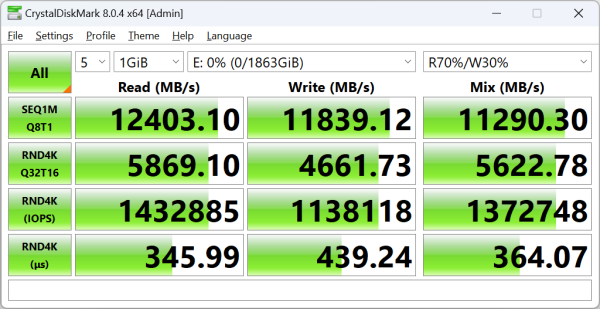
According to Crucial, the 2TB T700 is capable of reading at 12,400 MB/s and writing at 11,800 MB/s. As you can see, the drive had no problems reaching these speeds in CrystalDiskMark's sequential read and write tests.

As you'd expect, the T700 wasn't as fast when tested with the "real world" profile which uses a single thread and a much lower queue depth. Nevertheless, it was still able to read at 9,531 MB/s and write at more than 10,200 MB/s.
ATTO Disk Benchmark 4.01:
I also used ATTO Disk Benchmark to test the T700's sequential read and write speeds. The tests are run using blocks ranging in size from 512B to 64 MB and the total length set to 256MB.
When tested with ATTO, the T700's read speeds topped out at about 11.57 GB/s and its write speeds at 11.06 GB/s.
AS SSD:
AS SSD is a relatively new benchmark designed specifically for solid state drives. The application contains five synthetic tests used to determine the sequential and random read and write performance of a drive.
AS SSD also includes a copy benchmark. This test copies an ISO (two large files), program (many small files) and game (small and large files), returning the speed and duration of each.
HD Tune Pro 5.75:
Next, I ran a series of tests using HD Tune Pro. This hard disk utility measures a drive's performance by testing its sequential read and write speeds as well as its access time, burst rate and CPU usage. For this review, I'm also going to use it to benchmark the T700's random read and write speeds, random access times and the number of operations per second.
The T700 performed relatively well when benchmarked with HD Tune. The drive had average read and write speeds of 6771.3 MB/s and 4,185.8.0 MB/s, respectively.
When reading 4KB blocks, the T700 reached 53,339 IOPS and had an average speed of 208.356 MB/s. The drive was even faster when writing, reaching 58,380 IOPS with an average speed of 228.049 MB/s.
Anvil's Storage Utilities:
Anvil's Storage Utilities is another benchmark designed with SSDs in mind. The standard storage benchmark measures a drive's performance by testing its transfer speeds, access times and IOPS.

Iometer:
Lastly, I ran a series of tests using Iometer. This tool can be configured to benchmark a number of things. In this case, I used it to measure the T700's read and write speeds and the number of operations per second. The tests were run using random bytes and a queue depth of 3.
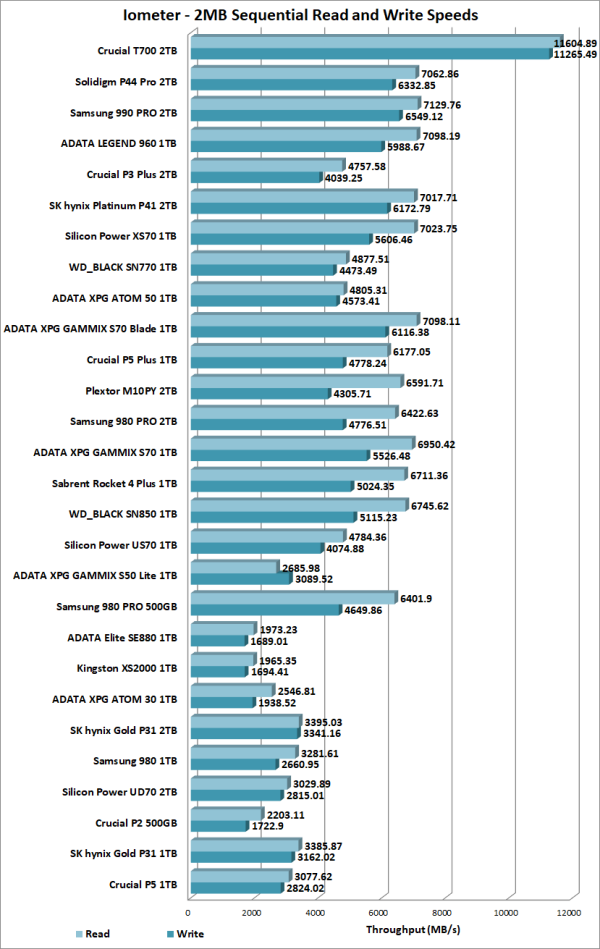
The T700's performance was very similar to what we saw in our other tests. The drive was able to read at 11,604.89 MB/s and write at 11,265.49 MB/s.

The T700 also performed very well when doing random reads and writes. In our tests, the drive was able to read at 499.14 MB/s and write at a blazing 1,297.26 MB/s.

According to Crucial, the 1TB T700 is capable of 1,500K IOPS when reading and writing 4K blocks. With two threads and a queue depth of three, the drive reached 127,781 random read IOPS and 332,099 random write IOPS.

As with most drives, the T700 performed better with more threads and at higher queue depths. With sixteen threads and the queue depth set to 32, it reached 1,384,398 random read IOPS and 1,153,605 random write IOPS.
PCMark 8 - Storage Test:
PCMark 8 is a complete benchmark for Windows. It includes five benchmark tests, each designed around a specific scenario. The storage benchmark measures drive performance using real-world traces recorded from Adobe Creative Suite, Microsoft Office and a selection of popular games.
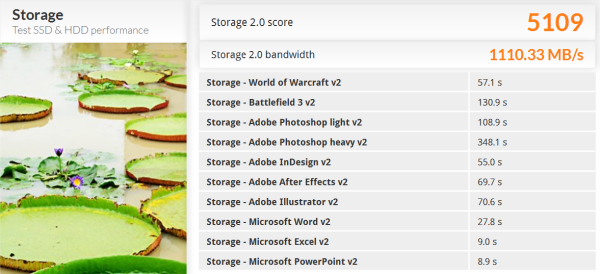
PCMark 8 also includes a consistency test which measures the performance consistency and degradation tendency of a storage system. The test reports the performance level at the start, the degraded steady-state and the recovered state as well as the number of iterations required to reach the degraded state and the recovered state. For this test, we are focusing on the Adobe Photoshop (Heavy) trace and will look at both the bandwidth and latency of the drive


The T700 did fairly well throughout PCMark's consistency test. While the average bandwidth dropped below 1,000 MB/s during a few of the phases, it was still faster than most of the PCIe 4.0 SSDs we've tested.
PCMark 10 - Full System Drive Benchmark:
PCMark 10's Full System Drive Benchmark uses a wide-ranging set of real-world traces from popular applications and common tasks to fully test the performance of the fastest modern drives. This benchmark produces an overall score as a measure of drive performance. Comparing devices is as simple as comparing scores. The tests also measure and report the bandwidth and average access time performance for the drive.
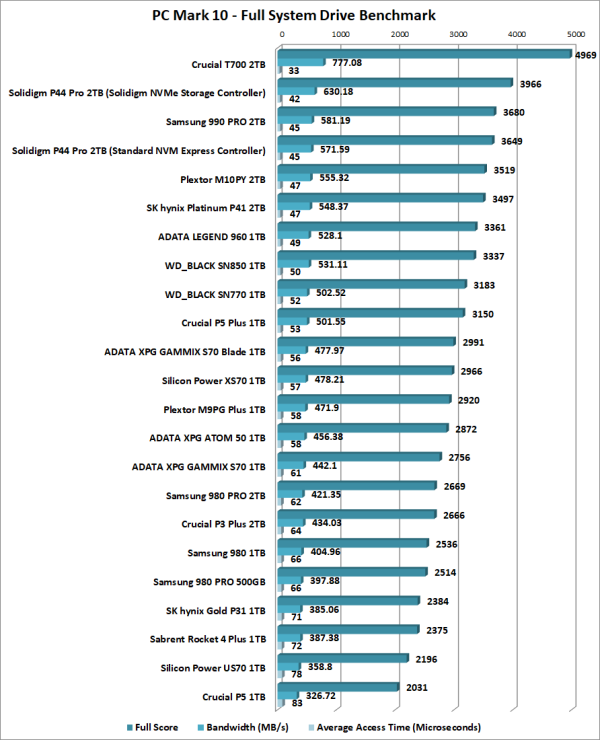
It should come as no surprise that the T700 did quite well in PCMark 10's Full System Drive Benchmark. Thanks to its high bandwidth and low latency, it took the top spot, beating all of the PCIe 4.0 SSDs we've tested.
Adaptive Thermal Protection:
While PCIe SSDs like the T700 offer impressive performance, they also generate a good amount of heat. To keep them from overheating, Crucial has implemented what they call Adaptive Thermal Protection. This technology monitors the temperature of a drive and will automatically reduce its performance when it reaches 81 ºC. If that isn't enough and the temperature continues to rise, Adaptive Thermal Protection will shut the drive down when it reaches 90 ºC.

Using my motherboard's M.2 SSD heatsink, the T700's temperature hovered around 36 ºC at idle. When pushed hard, the drive reached temperatures as high as 62 ºC when reading and 65 ºC when writing. With the temperatures staying well below 81 ºC, there was also no sign of thermal throttling.

The temperatures weren't quite as low with the heatsink-equipped T700. Looking at the screenshot below, you can see that the drive idled at around 41 ºC and reached temperatures as high as 71 ºC when reading and 78 ºC when writing. Nevertheless, the heatsink did its job as there was no sign of thermal throttling.

Final Thoughts:
Crucial has knocked another one out of the park with its new T700 SSD. Available with or without a heatsink, this M.2 form factor drive is powered by Phison's PS5026-E26 controller and is available with up to 4TB of Micron's industry-leading 232-layer 3D TLC NAND flash. Combine this with a large DRAM cache and an ultra-fast PCIe Gen5 x4 NVMe 2.0 interface and you have one of the fastest consumer NVMe SSDs on the market today. The T700 flew through our sequential transfer rate tests, reading at speeds as high as 12,403 MB/s and writing at more than 11,800 MB/s. It also did very well in our random write tests, producing more than 332,000 IOPS at low queue depths.
Of course, fast read and write speeds aren't the only things the T700 has to offer. The drive uses technologies like Dynamic SLC caching to optimize performance as well as multistep data integrity algorithms and Redundant Array of Independent NAND (RAIN) to protect data and prevent it from becoming corrupted. The T700 also features thermal and power loss protection, active garbage collection and built-in hardware-based encryption. To top it all off, it is one of the few drives to be optimized for Microsoft’s DirectStorage API. While games with DirectStorage support are still few and far between, this technology is expected to speed up load times immensely, especially with a high-performance NVMe SSD like the T700.
The Crucial T700 is available now in 1TB, 2TB and 4TB capacities. Prices for the heatsink-less version currently range from $180 up to $600, with the 2TB version reviewed here retailing for about $340. Otherwise the heatsink-equipped version will run you about $30 more.

Highs:
- Available in 1TB, 2TB and 4TB capacities
- PCIe 5.0 x4 interface with NVMe 2.0 protocol
- Phison PS5026-E26 controller
- Equipped with Micron 232-Layer B58R 3D TLC NAND
- Excellent sequential and random read and write speeds
- Small M.2 2280 form factor
- Large DRAM cache
- Dynamic SLC caching
- Supports Redundant Array of Independent NAND and Multistep Data Integrity Algorithms
- Built-in hardware-based encryption
- Supports TRIM and active garbage collection
- Thermal and power loss protection
- Available with or without heatsink
- Optimized for Microsoft’s DirectStorage API
- Includes Acronis True Image cloning software
- 5 year warranty
Lows:
- Can get very hot under heavy workloads
- Requires a heatsink
- Write speed drops when SLC cache is full
- Pricey


